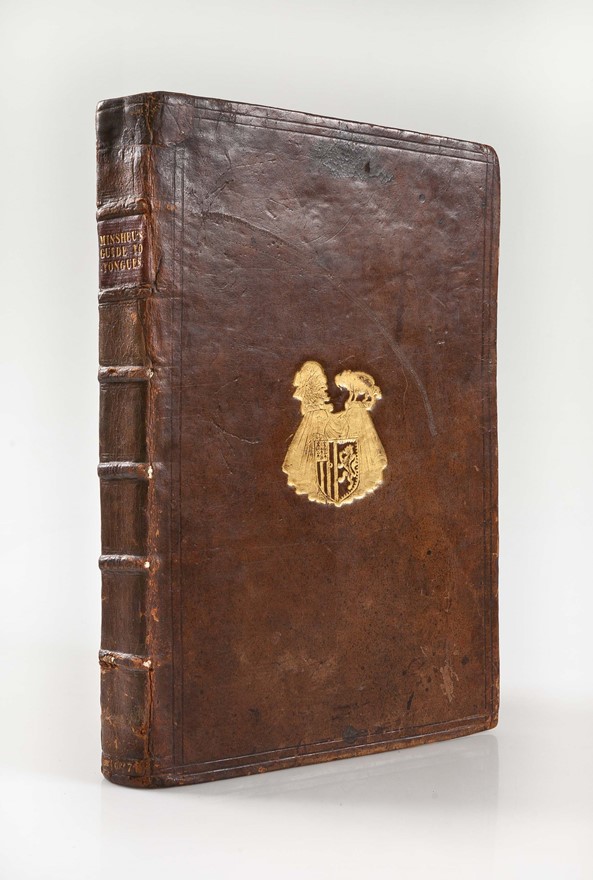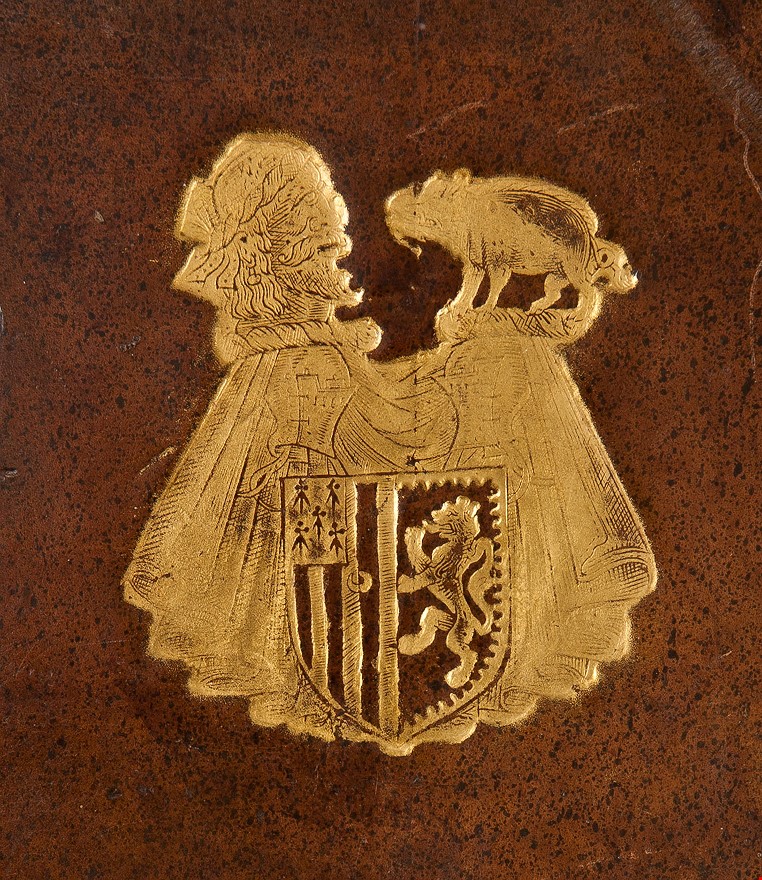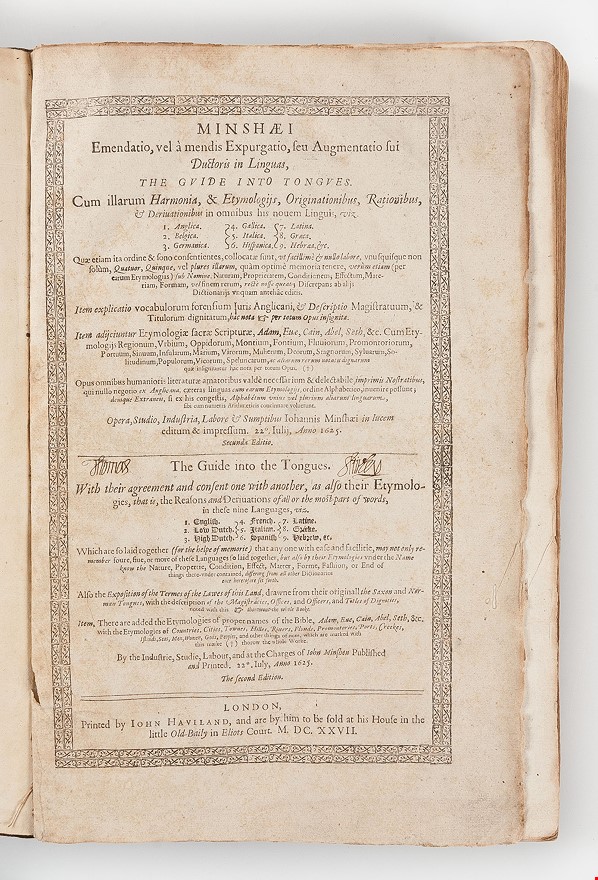Minshaei Emendatio, vel a mendis Expurgation, seu Augmentatio sui Ductoris in Linguas, the Guide into Tongues.
MINSHEU John (1627)
£2000.00
Please contact us in advance if you would like to view this book at our Curzon Street shop.
FROM THE LIBRARY OF SIR THOMAS SHIRLEY
Cum illarum Harminia, & Etymologijs, Originationibus, Rationibus, & Derivationibus in omnibus his novem Linguis, viz. 1. Anglica. 2. Belgica. 3. Germanica. 4. Gallica. 5. Italica. 6. Hispanica. 7. latina. 8. Graeca. 9. Hebraea, &c. [...] The Guide into the Tongues. With their agreement and consent one with another, as also their Etymologies, that is, the Reasons and Derivations of all or the most part of words, in these nine Languages, viz. 1. English. 2. Low Dutch. 3. High Dutch. 4. French. 5. Italian. 6. Spanish. 7. Latine. 8. Greeke. 9. Hebrew, &c. ... By the Industrie, Studie, Labour, and at the Charges of Iohn Minsheu Published and Printed. 22o. Iuly, Anno 1625.
Second Edition, fourth issue. Folio. [400 x 260 mm]. [4]pp, [380] pp. in double columns numbered 1-760; title within an ornament border. Lightly browned throughout, heavy in places, intermittently foxed, slight worming in the outer margin of the first few leaves, last few leaves with a dampstain at the outer half, rust-hole to the blank inner margin of D1-2, weakness from a paper flaw to the outer margin of L3 extending slightly into the text, closed tear to the blank margin of X1, dampstain to the outer side of the last few gatherings. Contemporary sprinkled calf, covers with two-line blind ruled border and in the centre the gilt arms block of Sir Thomas Shirley (joints rubbed and worn, upper joint worn through at the bands, a few scuffs with a long one on the upper cover, wear to the edges and corners, head and tail of the spine repaired; mid-19th-century endleaves).
London: by John Haviland,
STC 17947. The second editon of part 1 of the Ductor in Linguas (1617), without the Spanish-English Dictionary which had been reprinted separately in 1623 and formed part 2 of the 1617 edition. This second edition appeared in two issues in 1625 and was reissued in 1626 and 1627
"Minsheu hoped to make foreign-language learning easier for English speakers; consequently, for the first time in a multilingual dictionary, the headword was in English. It is followed by any cognates which might exist, an arrangement designed by Minsheu to assist the memory, as were the generous citations and the etymological explanations. It is unlikely that Minsheu had much success with his teaching methods, and doubt is cast on his scholarship in the light of his frequent plagiarisms. Nevertheless, his achievement was, in the face of unremitting toil and adversity, to produce a magnificent dictionary, The Guide into Tongues, which was cited by many later lexicographers, in particular by Stephen Skinner in his Etymologicon Linguae Anglicanae (1671).
Provenance: With the gilt arms block on the covers of Sir Thomas Shirley, Kt. (c. 1590-1654), antiquary, of Botolph's Bridge, Huntingdonshire, 3rd (2nd surviving) son of Sir George Shirley, 1st. Baronet, of Staunton Harold, Leicesteshire. He was knighted on 22 May 1622. The arms are Shirley (paly of six, a canton ermine, with a crescent for difference as a 2nd son) impaling Harpur (within a bordure engrailed a lion rampant); crests: a Saracen's head (Shirley) and a boar passant collard and chained (Harpur). John Morris's census of armorial bindings lists 4 examples of Shirley's arms block and two with the Harpur boar crest only.
"Shirley's main claim to fame was as a member of the circle of midland antiquarians associated with William Burton, William Dugdale, Sir Simon Archer, and Thomas Habington. He exchanged references with Archer and Burton, who visited him at Staunton Harold in the late 1620s; he collaborated with fellow Catholic Habington on his history of Worcestershire during the 1630s; and in May 1638 he joined with Dugdale, Sir Edward Dering, and Sir Christopher Hatton to form a group calling itself the Students of Antiquity who were dedicated to co-operative research in the London archives. ... His parents were both dedicated Catholics and his wife's father was renowned for suffering for his faith during Elizabeth's reign. Thomas followed their examples. He remained a recusant throughout his life, enduring heavy financial penalties - which led to the seizure and mortgaging of his manor at Botolph's Bridge - and also a spell of imprisonment. ... Sir Thomas spent part of the 1640s in exile in France, but had returned to Staunton Harold by 1653 and died the following year." (ODNB).
19th-century label of Gloddaeth Hall, Caernarvonshire, North Wales, one of the seats (since 1460) of the Mostyn family; Mostyn Hall, Flintshire, pencil shelfmark; by descent to Roger, 5th Baron Mostyn, sale, Christie, 16/10/1974, lot 921, £50 to C. W. Traylen.
Stock Code: 62259






